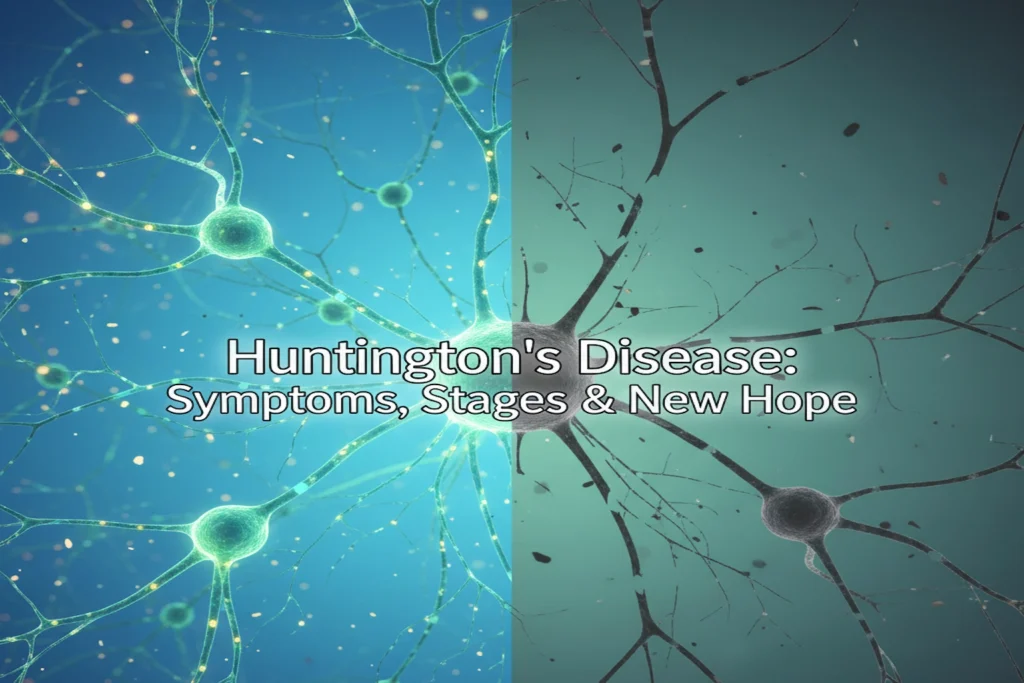Imagine living with a state that slowly changes the way you move, think, and feel, while knowing it is written in your DNA long before the first symptom shows up. That’s the actual reality of Huntington’s disease (HD). It is a rare but pernicious genetic disorder that affects thousands of families worldwide.
For decades, Huntington’s disease always has been compared to a cruel mix of Parkinson’s, Alzheimer’s, and ALS, combining problems with movement, memory, and behavior. But 2025 has brought a turning point. But for the first time, clinical trials are showing that gene therapy may actually slow the disease, offering hope where there was once only inevitability.
In this guide, we’ll explore everything you need to know about Huntington’s; its symptoms, causes, stages, and the groundbreaking research changing the future for patients and families.
What is Huntington’s Disease?
Huntington’s disease is a progressive brain disorder that slowly damages your specific nerve cells, especially in areas that control movement, learning, and emotional regulation. The condition is mostly inherited, which means it runs in families. Its symptoms usually appear between ages 30 and 50.
Unlike many illnesses that develop due to lifestyle or environmental factors, Huntington’s is inherent in the genes. As you all are already aware, if a parent carries the faulty gene, each child has a 50% chance of inheriting it. This cruel lottery makes the disease not just a medical condition but also an emotional and generational burden sometime.
While relatively rare, affecting about 1 in 10,000 people worldwide; Huntington’s has a profound impact now. Families often spend years watching their loved ones lose independence while fearing for their own genetic fate.
In short: Huntington’s disease is not just about the person diagnosed; it reshapes the lives of entire families.
Causes & Genetics of Huntington’s Disease
At the root of Huntington’s disease lies a mutation in a single gene named as: the HTT gene. This gene normally contains instructions for making a protein called huntingtin, which plays a role in brain cell function.
The problem happens when a section of the gene, known as a CAG repeat, becomes too long.
- A typical HTT gene has 10–35 repeats.
- In Huntington’s, the number jumps to 36 or more.
- The more repeats, the earlier and more severe the disease tends to be.
This expanded DNA sequence causes the huntingtin protein to fold incorrectly, leading to a toxic buildup inside brain cells. Over time, these cells, especially in the basal ganglia and cerebral cortex begin to die off. That’s why patients develop uncontrolled movements (known as chorea), mood swings, and memory loss.
Its inheritance pattern is autosomal dominant, meaning:
- Only one faulty copy of the gene is enough to cause the disease.
- Every child of an affected parent has a 50/50 chance of inheriting it.
This genetic certainty makes Huntington’s one of the most feared hereditary disorders. It becomes dangerous, especially because symptoms usually appear during the prime of life. It means it gets discovered when people are raising families or building careers.
Huntington’s Disease Symptoms & Early Signs
One of the hardest parts about Huntington’s is that symptoms don’t arrive all at once. They creep in, often starting gradually in a person’s 30s or 40s. At first, it may look like stress, clumsiness, or mild forgetfulness. Over time, the changes become impossible to ignore.
What is the first sign of huntington’s disease
Early Signs to Watch For
- Movement changes (motor symptoms): Slight fidgeting, twitching, or clumsiness. People may drop things, stumble more often, or notice small uncontrolled movements.
- Cognitive changes: Trouble focusing, difficulty planning tasks, or forgetting details. It can sometimes be mistaken for early dementia.
- Emotional/behavioral shifts: Irritability, mood swings, depression, or withdrawal from social life.
Because these symptoms overlap with other conditions as well, so early diagnosis often requires genetic testing combined with neurological exams.
The Main Categories of Symptoms
- Movement Symptoms
- Involuntary jerking or writhing (known as chorea)
- Muscle rigidity or stiffness
- Problems with balance and coordination
- Slurred speech or difficulty swallowing
- Cognitive Symptoms
- Difficulty organizing or prioritizing tasks
- Short-term memory loss
- Trouble learning new information
- Poor impulse control
- Psychiatric & Behavioral Symptoms
- Depression and anxiety
- Irritability or anger outbursts
- Apathy (lack of motivation)
- Obsessive-compulsive behaviors
It’s important to note: Not every patient experiences all symptoms in the same order. The progression varies, which makes personalized care essential.
The 5 Stages of Huntington’s Disease
Doctors often describe Huntington’s progression in five stages. Understanding these stages helps you as part of the families to prepare for what’s ahead.
- Stage 1: Early Stage
- Subtle movement problems
- Mild changes in mood and thinking
- Still able to work and manage daily life
- Stage 2: Early-Intermediate Stage
- More noticeable involuntary movements
- Difficulty with complex tasks at work
- Some personality or behavioral changes
- Stage 3: Late-Intermediate Stage
- Increased falls and difficulty walking
- Trouble swallowing
- Requires help with some daily activities
- Stage 4: Early Advanced Stage
- Major motor issues, speech and swallowing difficulties
- Increased dependence on caregivers
- Emotional and cognitive decline intensifies
- Stage 5: Advanced Stage
- Full-time care needed now
- Severe movement and cognitive impairment
- Patients eventually lose the ability to speak, eat independently, and walk
The average time from first symptoms to advanced stage is 15–20 years, but supportive care can greatly improve comfort and quality of life.
A Breakthrough in September 2025: Gene Therapy Offers New Hope
For decades, Huntington’s disease was considered untreatable. Doctors could only manage symptoms, not slow down the disease itself. But in 2025, researchers at University College London announced something remarkable: a gene therapy that slowed Huntington’s progression by up to 75%.
Sounds almost too good to be true, right? Here’s how it works:
- A safe, modified virus is used to deliver a special DNA sequence into brain cells.
- Once inside, these cells begin producing tiny pieces of genetic material called microRNA.
- These microRNAs act like “off switches,” silencing the faulty instructions that create toxic huntingtin proteins.
- As a result, the brain produces less of the harmful protein that kills neurons.
The treatment involves 12–18 hours of delicate brain surgery. While that may sound intense, the results are nothing short of astonishing. Patients who were expected to decline rapidly because of their Huntington’s disease life expectancy, can now return to work, keep walking, or enjoy years of higher-quality life.
The caveat? It’s expensive, complex, and not yet widely available. Clinical trials are ongoing, and approval is expected around 2026 in the US, with Europe and the UK to follow. Still, for the first time ever, families affected by Huntington’s have reason to hope.
Living with Huntington’s Disease: Care & Lifestyle Tips
Even with promising research, managing Huntington’s today means focusing on quality of life. Here are some practical, research-backed tips used in huntington disease treatment:
- Regular physical activity: Gentle exercises (like walking, stretching, or tai chi) help maintain balance and coordination.
- Speech & swallow therapy: Early support can delay complications like choking or weight loss.
- Balanced diet: High-calorie, nutrient-rich foods are often needed because involuntary movements burn extra energy.
- Mental health support: Counseling and medications for depression, anxiety, or irritability are crucial for both patients and families.
- Support networks: Huntington’s doesn’t just affect one person, it also affects whole families. Connecting with Huntington’s disease associations and support groups can ease the journey.
FAQs About Huntington’s Disease
Can you live a normal life with Huntington’s disease?
Not exactly “normal,” but many people live fulfilling lives for 10–20 years after diagnosis. With supportive care, therapies, and now the possibility of gene therapy, patients can continue working. They can also spend time with loved ones, and enjoy hobbies much longer than in the past.
What are the early signs of Huntington’s disease?
The earliest signs are often subtle, small jerky movements, mood changes, or trouble concentrating. Family and friends sometimes notice personality shifts (like irritability or depression) before the person themselves realizes something is wrong.
What are the behaviors of someone with Huntington’s disease?
Behavioral changes may include irritability, impulsiveness, obsessive routines, apathy, or aggression. These aren’t character flaws, they’re direct results of changes in the brain caused by the disease. With the right medical and emotional support, these behaviors can be managed.
What are the 5 stages of Huntington’s?
Huntington’s generally progresses through five stages:
- Early stage: Subtle symptoms, independent living possible.
- Early-intermediate: Noticeable motor/cognitive changes.
- Late-intermediate: Needs some daily assistance.
- Early advanced: Major motor and speech issues, more dependent.
- Advanced: Full-time care required, severe impairment.
Final Thoughts
Huntington’s disease is devastating, but for the first time in history, there’s genuine hope. With gene therapy breakthroughs, advances in supportive care, and growing awareness, families now have more tools than ever to face this challenge.
The journey is not easy, but science is rewriting the story of Huntington’s. And in this new chapter, patients and families may get to hold on to decades of good-quality life, something that once felt impossible.


